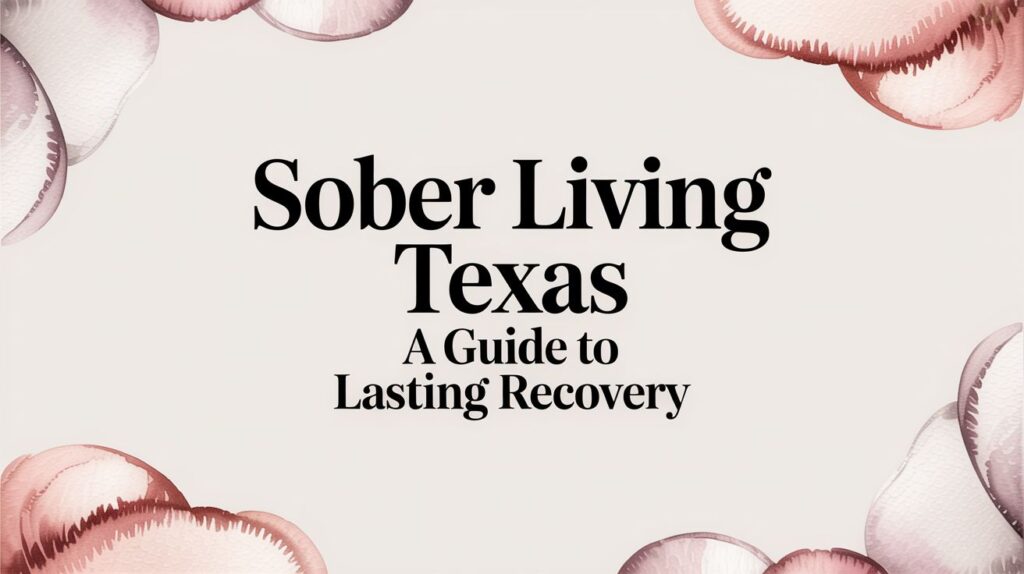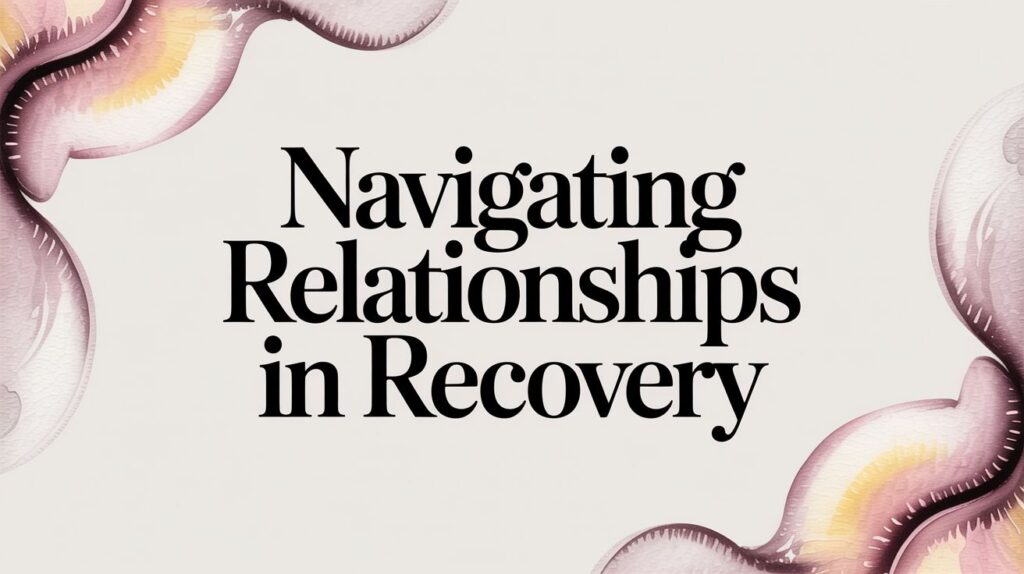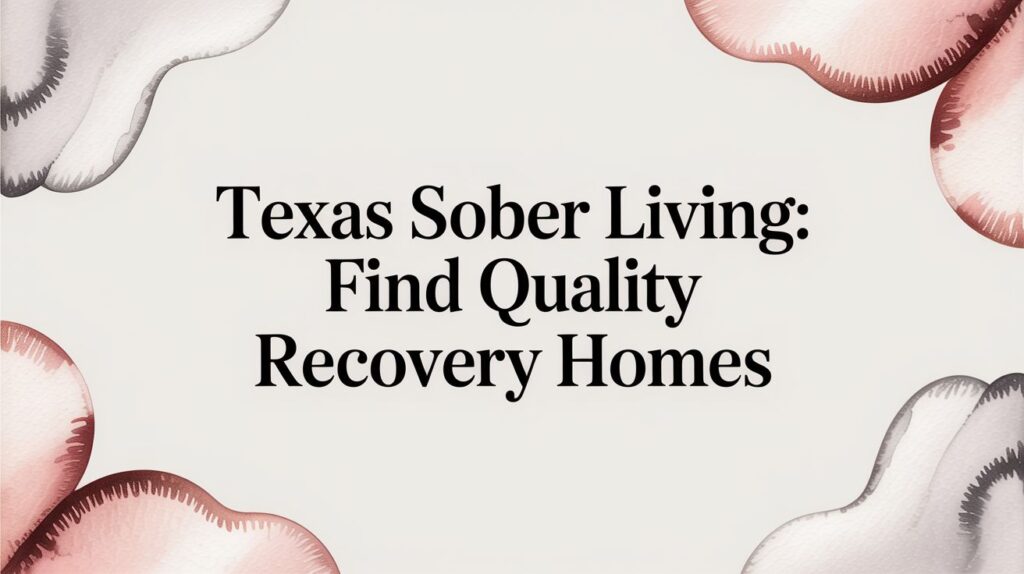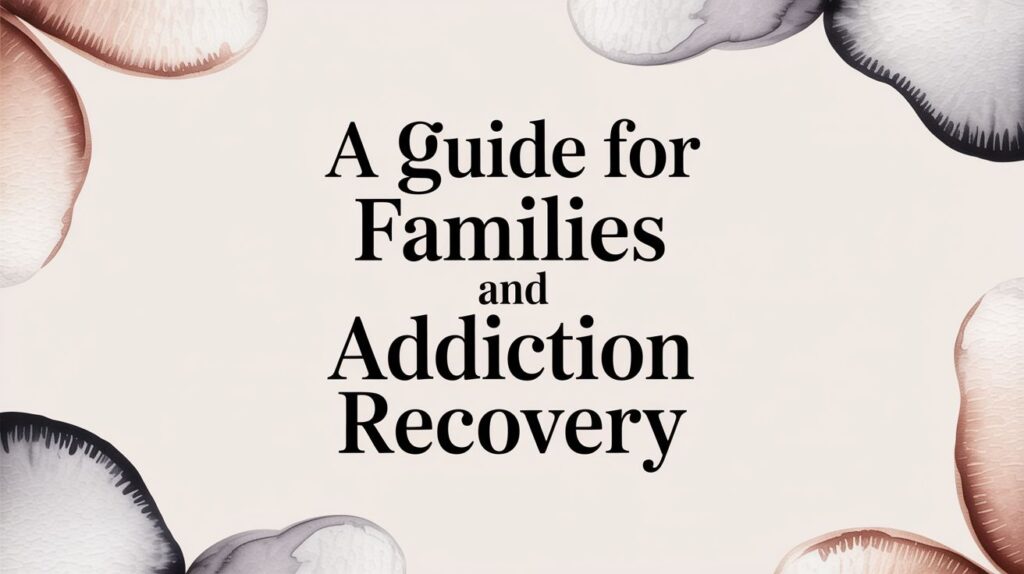Sober living in Texas provides a structured, alcohol- and drug-free environment that serves as a vital bridge between intensive addiction treatment and the full return to daily life. It’s a place to build accountability, find peer support, and have a safe space to put down a strong foundation for recovery.
What Is Sober living in Texas
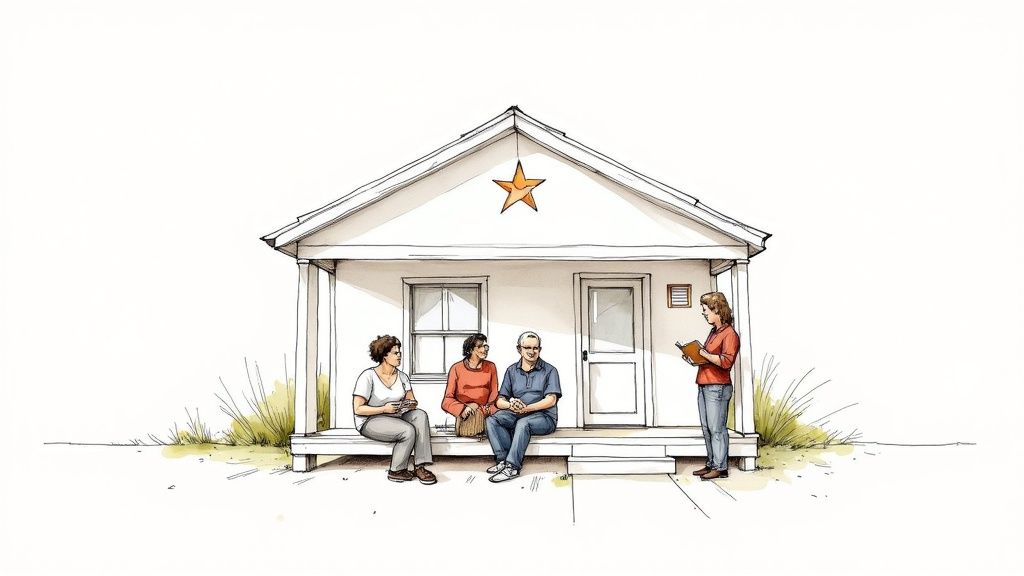
Walking out of a treatment facility is a huge milestone, but it's also an incredibly vulnerable time. Sober living homes are designed for this exact transitional phase. Think of them less like a treatment center and more like a supportive, structured home where you can practice the skills you learned in rehab while starting to handle real-world responsibilities again.
These homes are much more than just drug-free housing; they are genuine communities built on mutual support and a shared commitment to sobriety. The entire point is to help residents establish healthy routines, sharpen their coping skills, and solidify their new sober life in a stable, predictable setting.
The Structure of Daily Life
Life inside a sober living home is intentionally structured to foster personal responsibility and growth. While every home has its own specific set of guidelines, most operate on a common framework designed to eliminate chaos and encourage positive habits.
Key components of this structure almost always include:
- House Rules and Curfews: These rules are firm and non-negotiable, creating a safe and predictable environment for everyone. This often covers visitor policies, overnight stay restrictions, and set times to be home each night.
- Mandatory Drug and Alcohol Testing: Regular, random testing is standard practice. It protects the integrity of the home's substance-free commitment and holds every single resident accountable.
- Shared Household Responsibilities: Residents typically share chores like cooking and cleaning. This isn't just about keeping the house tidy; it’s about rebuilding life skills, promoting teamwork, and giving everyone a sense of ownership in the community.
- Meeting and Therapy Attendance: Most homes require residents to be active participants in their recovery. That means consistently attending 12-Step meetings, outpatient therapy sessions, or other approved support groups.
The Role of the House Manager
A critical piece of any well-run sober living home is the house manager. This person, often in recovery themselves, lives on-site to provide guidance, enforce the rules, and help mediate any conflicts that pop up. They serve as both a mentor and a source of stability, making sure the home stays focused on its primary mission: supporting recovery.
To give you a quick snapshot, here are the core elements you can expect from a sober living home in Texas.
Sober Living in Texas at a Glance
This table breaks down the key characteristics of Texas sober living homes to provide an immediate overview.
| Characteristic | Description |
|---|---|
| Environment | A structured, substance-free residential home shared by peers in recovery. |
| Primary Goal | To provide a safe transition from intensive treatment back to independent living. |
| Key Features | House rules, curfews, mandatory drug testing, shared chores, required meeting attendance. |
| Oversight | Typically managed by a live-in house manager who enforces rules and provides support. |
| Integration | Residents are usually required or encouraged to work, go to school, or attend outpatient programs. |
| Community | Built on peer support, accountability, and shared recovery goals among residents. |
| Typical Cost | Ranges from $1,500 to $2,000 per month, covering rent, utilities, and community support. |
This model is all about building the scaffolding needed for long-term success.
A sober living environment provides the essential framework for rebuilding a life. It blends the freedom of independent living with the structure and peer support needed to successfully navigate the fragile early stages of sobriety.
This supportive structure is an investment in lasting recovery. Costs in Texas generally mirror national trends, with rent, utilities, and access to this vital community often ranging from $1,500 to $2,000 per month. When you learn about the numerous benefits of sobriety, it becomes clear why this investment is so incredibly valuable.
Navigating Regulations for Texas Sober Homes
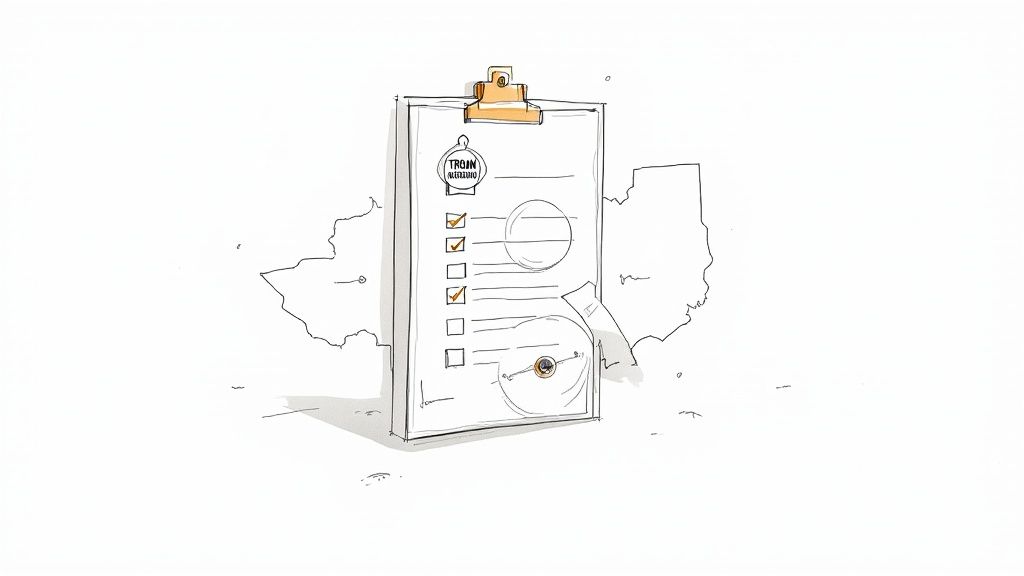
When you start looking for a sober living Texas home, it’s natural to assume there’s a clear state licensing process, just like there is for clinical treatment centers. The reality, however, is a lot murkier—and it demands your full attention.
Unlike rehabs or intensive outpatient programs, Texas has no mandatory state-level license requirement specifically for sober living homes. This is a critical distinction. It means almost anyone can rent a house, call it a sober living facility, and start accepting residents, no matter their qualifications or the safety of the environment.
This lack of mandatory oversight puts the burden of quality control squarely on your shoulders. It makes understanding the voluntary systems for certification not just helpful, but absolutely essential for finding a safe, supportive place to heal.
The Role of Voluntary Accreditation
To bring some order to this unregulated space, a system of voluntary accreditation has emerged. Think of it like a "Good Housekeeping Seal of Approval" for sober homes. While it's not legally required, this certification is a powerful signal that a home has committed to meeting specific standards for safety, ethics, and professional operations.
This process is handled by independent organizations that evaluate homes against a checklist of best practices. For a home, getting accredited takes a significant investment of time and money, showing a real dedication to providing a high-quality recovery environment. For you, it provides an extra layer of confidence that the facility is professionally managed and focused on resident well-being.
Understanding TROHN and NARR Standards
The main group handling this in Texas is the Texas Recovery Oriented Housing Network (TROHN). TROHN is the state-level affiliate of the National Alliance for Recovery Residences (NARR), the organization that sets the gold standard for recovery housing nationwide.
When a sober living home is "TROHN-certified," it means it has been thoroughly vetted and meets the NARR standards for quality and care. These standards cover several crucial areas:
- Safety and Physical Environment: The house must be clean, well-maintained, and physically secure for every resident.
- Ethical and Rights-Based Operations: The facility must operate with integrity, respecting residents' rights and maintaining fair, transparent policies.
- Recovery Support: The home has to actively support the recovery journey, often by connecting residents to meetings, therapy, and peer support networks.
- Good Neighbor Policies: The facility is expected to be a responsible and respectful member of its local community.
Choosing a TROHN-certified home is one of the most reliable shortcuts to finding a reputable sober living option in Texas.
The current accreditation landscape in Texas highlights a critical gap. While dedicated organizations are working to certify quality homes, a significant number of facilities operate without any formal oversight, creating a precarious situation for those in early recovery.
The numbers really drive this point home. As of recent data, only 407 recovery homes in Texas are accredited or chartered. The Texas Recovery Oriented Housing Network has accredited just 81 of these, leaving around 300 facilities at risk of losing state funding because they lack accreditation. You can learn more about the challenges with recovery home accreditation in Texas to grasp the full scope of the issue.
Why Due Diligence Is Non-Negotiable
This situation makes one thing crystal clear: accreditation should be your starting line for research, not the finish line. Because the system is voluntary, many uncertified homes are out there. While some might be run by well-meaning people, others could be missing the structure, safety protocols, and ethical oversight that are non-negotiable for a healthy recovery environment.
Ultimately, navigating the world of sober living in Texas requires you to be an informed consumer. By understanding the role of TROHN and making certified homes your top priority, you can dramatically lower your risks and find a place that will genuinely support your path to lasting sobriety.
Sober Living Homes vs. Halfway Houses: What's the Real Difference?
In the recovery world, you’ll often hear people use terms like “sober living home” and “halfway house” as if they’re the same thing. They’re not. While both offer a drug- and alcohol-free place to live, they operate on fundamentally different models and serve very different needs. Getting this distinction right is one of the most important first steps in finding the right support for your recovery in Texas.
Let's break it down with a simple analogy. Think of a halfway house as a structured, transitional program—like a bridge from an institution back to society. A sober living home, on the other hand, is more like a supportive, shared apartment with roommates who are all committed to a recovery lifestyle. The differences in who they serve, how they're funded, and their ultimate purpose are huge.
The Halfway House Model: A Bridge from Institution to Community
The term “halfway house” is quite literal. It’s designed for individuals who are “halfway” out of an institutional setting—most often, a state prison or jail. Because of this direct link to the criminal justice system, halfway houses are typically funded by government agencies and operate under their strict rules and supervision.
The primary goal here isn't just sobriety; it's successful societal re-entry. Residents are there to find a job, meet the conditions of their parole or probation, and learn to navigate daily life again under close watch. Sobriety is a non-negotiable rule, but the day-to-day focus is on compliance and reintegration.
- Who Lives There: Primarily individuals mandated by the justice system upon release.
- How It's Funded: Usually with state or federal government funds.
- Who's in Charge: Overseen or contracted by agencies like the Department of Corrections.
- Length of Stay: The duration is often predetermined and tied to a person’s sentence or parole requirements.
- The Vibe: Highly structured and rule-driven, with a heavy emphasis on monitoring and accountability to the justice system.
The Sober Living Home Model: A Community Built on Recovery
A sober living home, by contrast, is a private home where the residents voluntarily choose to live and pay rent to support their recovery. There's no connection to the justice system. The one and only purpose of a sober living home is to create a safe, supportive, peer-driven environment where recovery from addiction is the central focus.
Most residents move into a sober living home after completing a treatment program like a PHP or IOP. They aren't being forced to be there; they want to be there to build a solid foundation for their new life. The structure is built around mutual accountability and shared goals, promoting independence within a supportive community.
The biggest difference comes down to choice. Residency in a halfway house is often a condition of release. Choosing a sober living home is a proactive, personal decision an individual makes to invest in their long-term sobriety.
This core difference in purpose creates a completely different culture. While both environments have rules (like curfews and mandatory drug testing), the atmosphere in a sober living home is collaborative, built on the shared desire for a better way of life.
Comparing Recovery Housing Options in Texas
Choosing between these two models for sober living in Texas really boils down to your specific situation and recovery goals. The table below lays out the key differences side-by-side to make the distinction crystal clear.
| Feature | Sober Living Home | Halfway House |
|---|---|---|
| Primary Focus | Building a supportive, long-term recovery lifestyle. | Structured re-entry from an institution (e.g., prison). |
| Funding | Private; funded entirely by rent from the residents. | Public; funded by state or federal government agencies. |
| Resident Profile | Individuals who voluntarily choose to be there. | Individuals often mandated by the justice system. |
| Rules & Structure | Community-focused rules designed to support sobriety. | Strict, rigid rules focused on legal compliance. |
| Stay Duration | Flexible; based on individual recovery progress. | Fixed term; often determined by a legal sentence. |
So, what's the bottom line? A halfway house plays a vital role as a supervised bridge for those leaving the justice system. A sober living home, however, is a community you choose to join—a place to immerse yourself in a culture of recovery, build strong peer relationships, and lay the groundwork for a life free from addiction.
How to Choose the Right Sober Living Home
Picking a sober living home is one of the biggest calls you'll make in early recovery. This isn’t just about finding a roof over your head; it’s about choosing the community and structure that will either fuel your progress or stall it out. A great home is a launchpad for lasting sobriety, but a poorly run one can introduce a whole new set of risks and instability.
Making this choice can feel overwhelming, especially when you’re already in a vulnerable spot. The trick is to look past the website photos and use a clear framework to evaluate your options. Think of yourself as an investigator, gathering the facts to make sure the environment is a perfect match for your recovery needs.
This means digging into a home's culture, its rules, the people who run it, and its core philosophy. It’s about asking tough questions and knowing what red flags to watch for.
Start with Accreditation and Licensing
Before you even think about a tour, your first move is to check for credentials. As we've covered, Texas doesn't mandate state licensing for sober homes. This makes voluntary accreditation the single most important sign of a quality, safe, and ethical operation.
Look for a certification from the Texas Recovery Oriented Housing Network (TROHN), which is the state affiliate of the National Alliance for Recovery Residences (NARR). A TROHN seal of approval means the home has passed a rigorous inspection covering everything from safety protocols to ethical practices and recovery support.
- Ask Directly: When you call a potential home, your very first question should be, "Are you TROHN-certified?" If they are, they’ll be proud to say so.
- Verify Independently: Don't just take their word for it. Head over to the TROHN website and confirm their certification is active.
- Understand the Levels: NARR has different levels of support. Make sure the home’s designated level provides the amount of structure you actually need.
Think of this first step as a powerful filter. It immediately weeds out any place that hasn't committed to meeting recognized standards of care.
Evaluate the Rules and Structure
Every sober living home runs on a set of rules, but not all rulebooks are created equal. You’re looking for a structure that’s firm enough to ensure safety and accountability but not so rigid that it crushes personal growth. The goal is to build responsibility, not just demand blind compliance.
When you visit or interview, ask for a printed copy of the house rules and the resident agreement. Pay close attention to these key areas:
- Drug and Alcohol Testing Policy: How often do they test? Is it random? What happens immediately after a positive test? A clear, predictable, zero-tolerance policy is non-negotiable.
- Curfews and Visitor Policies: What are the weeknight and weekend curfews? How are guests and overnight passes handled? These rules tell you a lot about the home’s approach to balancing freedom with structure.
- Meeting and Program Requirements: Is attendance required at 12-Step meetings, outpatient therapy (IOP/PHP), or both? A home that insists on connections to clinical and peer support is a huge green flag.
- Household Responsibilities: How are chores managed? Is there a clear system for keeping the house in order? Sharing responsibility builds community and teaches personal accountability.
A well-run sober living home uses its rules to teach life skills, not just to control behavior. The whole point is to internalize discipline and routine so that they become second nature long after you've moved on.
Finding a good fit isn't always easy, partly because the demand for recovery housing in Texas is much greater than the supply. The state ranks a dismal 33rd in the nation for recovery homes per capita, with only about 2.06 houses for every 100,000 people. This shortage means a staggering 218 out of 254 counties in Texas have no identified recovery housing at all, making a thorough evaluation of the options you do have even more critical. You can dig into the data yourself in the full National Study of Treatment and Addiction Recovery Residences.
Assess the Staff and Support System
The people running the home are every bit as important as the rules they enforce. A great house manager is more than a landlord; they’re a mentor, a guide, and a steady source of support. They should have solid experience in recovery and a genuine desire to see others succeed.
As you talk with the staff, keep these questions in mind:
- Experience and Training: What are their qualifications? Are they in recovery themselves, and if so, for how long? How long have they been working in this field?
- Availability: Is there staff on-site 24/7? If not, what’s the plan for emergencies or when you need support after hours?
- Attitude and Demeanor: Do they come across as compassionate but firm? A good manager can hold residents accountable to the rules without being punishing, creating an atmosphere of mutual respect.
At the end of the day, choosing the right sober living Texas home is an investment in your future. By carefully vetting the accreditation, structure, and staff, you can confidently pick an environment that will protect your sobriety and set you up for long-term success.
Pairing Sober Living with Outpatient Treatment
Think of it like this: combining a sober living home with an outpatient treatment program is like pairing a skilled personal trainer with a structured nutrition plan. One gives you the expert therapeutic guidance (the trainer), while the other provides the daily, supportive environment you need to make those lessons stick (the nutrition plan). This powerful combination creates a complete, real-world recovery experience that is far more effective than trying to tackle either part alone.
Outpatient programs, whether a Partial Hospitalization Program (PHP) or an Intensive Outpatient Program (IOP), deliver the essential clinical care. This is where you get individual therapy, group sessions, and workshops that build new coping skills. But what happens when the sessions end for the day? You have to return to your own environment—and that can be a massive hurdle if it’s unstable or full of triggers.
This is exactly where a high-quality sober living Texas home proves its worth. It ensures that the hours outside of your clinical treatment are just as focused on recovery as the hours inside it.
The infographic below shows the key pillars to look for when choosing a home that will genuinely support your recovery.
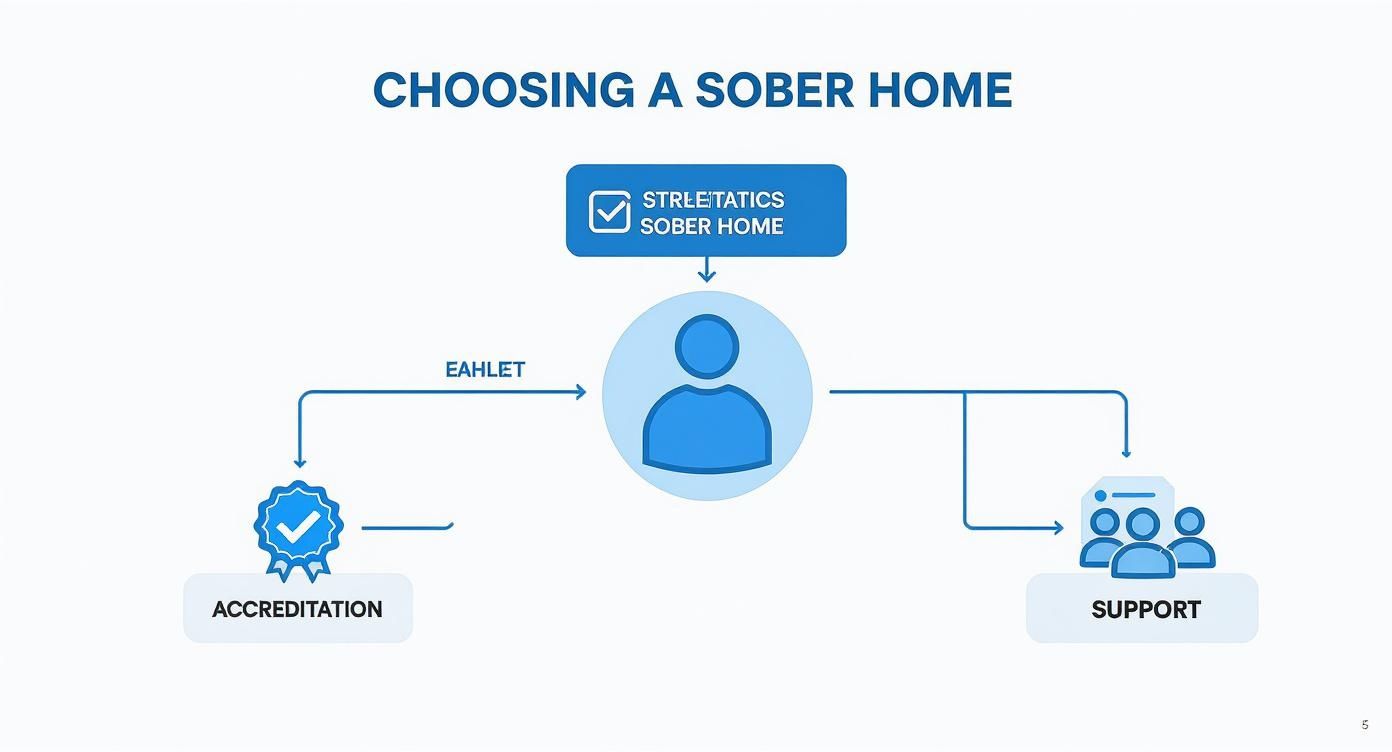
As the visual makes clear, a successful sober living home balances formal accreditation, a well-defined structure, and a strong network of peer support.
Creating a Cycle of Reinforcement
When you pair sober living with outpatient care, you create a positive feedback loop. What you learn in therapy during the day gets put into practice that same evening in a safe, supportive home. This real-time application is the secret sauce for turning theoretical knowledge into a lived reality.
Imagine you’ve just had a tough group therapy session where you dug into some deep-seated issues. Instead of going back to an empty apartment or a stressful family dynamic, you go home to people who get it. You can process what happened with peers who have been there, reinforcing the hard work you did in therapy and heading off feelings of isolation.
Sober living acts as the practical, everyday container for the clinical work done in outpatient treatment. It transforms therapy from a scheduled event into an integrated lifestyle, dramatically improving the odds of sustained recovery.
This integrated model offers some serious advantages:
- Enhanced Accountability: You're accountable to both your clinical team and your housemates. This creates a strong support network that leaves very little room for relapse to gain a foothold.
- Immediate Peer Support: After a challenging therapy session, being able to talk it through with peers who understand is an incredibly powerful tool for managing emotions and staying encouraged.
- Smoother Transitions: This setup bridges the gap between different levels of care, making the step-down from an inpatient or PHP setting feel less jarring and much more sustainable.
- Real-World Practice: It’s a safe space to practice all the new coping skills, communication techniques, and boundary-setting you're learning in real, everyday situations.
A Coordinated Path to Healing
For this model to work best, communication between the sober living staff and the outpatient treatment team is crucial. The house manager can give therapists valuable insight into how a resident is progressing, what they're struggling with, or where they're succeeding in the home environment. This collaborative approach ensures the clinical plan is always aligned with your real-world needs.
A huge part of recovery for many is moving past shame, and therapies like Compassion Focused Therapy for healing shame and self-criticism are often a key part of a quality outpatient curriculum. Having a supportive home to return to makes that healing work even more effective.
Ultimately, pairing these two services is about building a complete ecosystem of support. If you’re exploring your treatment options, it's smart to ask about partnerships with sober living homes. You can learn more about finding the right outpatient drug rehab in Houston that can be integrated with this kind of living situation. This combination offers one of the most effective strategies for building a strong, resilient foundation for lifelong sobriety.
The Family’s Role in Sober Living Success
Addiction is often called a family disease, and for good reason. When a loved one moves into a sober living home, it’s not just their journey—the entire family system starts a parallel path of healing, adjusting, and learning a completely new way of relating to one another.
Your support during this phase can be a powerful tailwind for their recovery, but it requires a conscious shift. Old patterns have to give way to new, healthier ways of interacting. The goal is to become an ally in their recovery, not an unintentional obstacle.
This means finding the delicate balance between encouragement and enabling. It’s a transition from being the family fixer to empowering them to solve problems for themselves. Making this change is fundamental not only to their long-term success but to your own peace of mind.
Setting Healthy Boundaries and Expectations
One of the most constructive things a family can do is get on board with the structure and rules of the sober living home. These residences are designed to build accountability, and your support of that mission is vital. Respecting the house policies is the first step toward rebuilding a healthy dynamic.
Here are a few key areas where your cooperation makes a huge difference:
- Visiting Hours: Stick strictly to the designated visiting times and locations. This shows respect for the entire community and its shared commitment to recovery.
- Communication Protocols: Important conversations, especially about sensitive issues, should often go through the house manager. This prevents mixed messages and keeps everyone on the same page.
- Financial Support: Avoid giving cash directly. If you're helping with costs, pay the rent to the house manager or offer support in non-monetary ways. This simple boundary helps ensure funds aren't accidentally diverted back to old habits.
Recovery requires the person with the addiction to take full ownership of their life. For families, this means learning to step back and allow natural consequences to happen, which is often the most loving and effective form of support.
This new approach can feel unnatural at first. If you’ve spent years navigating the chaos of addiction, learning to "detach with love" is a process. It takes time. To get a better handle on these dynamics, it can be helpful to explore resources on how to live with someone struggling with alcoholism and apply those same principles here.
Rebuilding Trust and Fostering Growth
Trust isn’t rebuilt overnight. It’s earned, one consistent and honest action at a time. For families, this means managing expectations and learning to celebrate the small, steady steps forward. Recovery is rarely a straight line, and your loved one will need your patience as they navigate this new life.
A crucial part of this process is showing up for family education or therapy programs when they’re offered. Many sober living homes in Texas work closely with outpatient centers that provide workshops or counseling specifically for families.
Jumping into these opportunities helps you understand the disease of addiction on a deeper level, sharpens your family's communication skills, and gives you a safe space to heal your own wounds. By becoming an educated and active participant, you transform from a worried observer into a powerful, constructive part of their long-term recovery team.
Common Questions About Sober Living in Texas
Making a decision this big brings up a lot of questions. When you’re looking for the right recovery housing, you need clear, straightforward answers you can trust. Let's tackle some of the most common things people ask about sober living in Texas so you can move forward with confidence.
Can I Keep My Job or Go to School?
Absolutely. In fact, it’s not just allowed—it's strongly encouraged. Sober living homes are specifically designed to help you get back into the rhythm of daily life. Holding a job, attending classes, or even volunteering is a huge part of that.
Most homes require you to be productively busy during the day. This isn’t just to keep you occupied; it builds financial independence and, more importantly, establishes a healthy routine. The whole point is to practice balancing real-world responsibilities with your commitment to recovery.
What Happens if Someone Relapses?
Every reputable sober living home has a zero-tolerance policy for substance use. This isn't about punishment—it's about protecting the safety and sobriety of every single person in the house. If a resident relapses, the house manager steps in immediately.
Usually, the person is removed from the home to make sure the environment stays safe for everyone else. But it doesn’t stop there. A good manager will connect that individual with a higher level of care, like a detox center or an inpatient program, to help them get back on track.
The number one job of a sober living home is to maintain a secure, substance-free environment for the entire community. Compassion is always part of the equation, but this commitment to safety is non-negotiable.
Are Pets Allowed in Sober Living?
This really varies from one home to the next, but as a general rule, most sober living facilities don’t allow pets. The reasons are practical: you have to consider potential allergies, extra cleaning duties, and the need to keep the environment focused on recovery for everyone.
That said, some homes do make exceptions or are set up to be pet-friendly. If bringing a pet is a deal-breaker for you, make sure to ask about the policy right up front when you’re doing your research.
How Long Can I Stay?
There’s usually no rigid deadline on how long you can stay. The length of your residence is flexible and really just depends on what you need and where you are in your recovery. Some people stay for a few months, while others find that living in that supportive community for a year or more is what works for them.
The goal is to move on when you feel you’ve built a solid foundation, have a strong support network, and are confident you can live independently without substances. It's a personal timeline that you, your support system, and the house staff figure out together. For a lot of people, this journey involves deep personal work, like the kind detailed in our guide on 4th-step inventory examples, which is key to building the self-awareness needed for real, lasting change.
At Altura Recovery, we know that building a new life takes courage, support, and the right tools. Our comprehensive outpatient programs are designed to work hand-in-hand with supportive living environments, giving you the clinical expertise you need to achieve lasting sobriety. Find out how we can support your journey by visiting us at https://www.alturarecovery.com.

